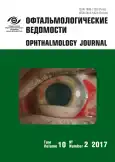Analysis of treatment results in dry eye syndrome patients after phacoemulsification by preservative-free 0.3% sodium hyaluronate eye drops
- Authors: Pirogov Y.I1, Butina G.M1, Oksentjuk A.A1, Khromova E.S1
-
Affiliations:
- Medical center “Admiraltejskie verfi” JSC
- Issue: Vol 10, No 2 (2017)
- Pages: 73-77
- Section: Articles
- URL: https://journals.rcsi.science/ov/article/view/6745
- DOI: https://doi.org/10.17816/OV10273-77
- ID: 6745
Cite item
Full Text
Abstract
Postsurgical dry eye syndrome is found in a substantial proportion of patients after phacoemulsification. Its onset could be explained by surgical trauma and by use of preservative-containing eye drops. In some patients, it causes substantial discomfort that continues unabated after 3-4 weeks after surgery.
Purpose. To investigate the results of 0.3% sodium hyaluronate instillation therapy used to treat dry eye syndrome after phacoemulsification.
Materials and methods. Basal tear secretion (Schirmer II test) and tear breakup time (TBUT) test were investigated in 33 patients with symptoms characteristic of dry eye syndrome in 1 month after phacoemulsification. These patients received 0.3% preservative-free sodium hyaluronate instillations for 30 days, whereupon Schirmer II and TBUT tests were repeated. Symptom dynamics was estimated according to the OSDI questionnaire scale.
Results. Mean values of basal tear secretion and TBUT tests were slightly below normal ones. In one month of treatment, the TBUT index associated with “Gilan Ultra Comfort” use became somewhat better: mean TBUT value appeared to be 9.8 ± 2.5 sec. OSDI questionnaire patient symptom score evaluation also revealed in patients a mild degree of xerosis severity. Mean score before treatment was 19.6 ± 10.0. Positive disease dynamics after “Gilan Ultra Comfort” use is confirmed by a significant decrease of OSDI score index up to 12.3 ± 6.3.
Full Text
##article.viewOnOriginalSite##About the authors
Yury I Pirogov
Medical center “Admiraltejskie verfi” JSC
Author for correspondence.
Email: visus1@yandex.ru
Head of ophthalmology department
Russian Federation, Saint Petersburg, RussiaGalina M Butina
Medical center “Admiraltejskie verfi” JSC
Email: Galinabutina@mail.ru
MD, ophthalmologist
Russian Federation, Saint Petersburg, RussiaAleksandr A Oksentjuk
Medical center “Admiraltejskie verfi” JSC
Email: os753@yandex.ru
MD, ophthalmologist
Russian Federation, Saint Petersburg, RussiaEkaterina S Khromova
Medical center “Admiraltejskie verfi” JSC
Email: gubaidullina90@mail.ru
MD, ophthalmologist
Russian Federation, Saint Petersburg, RussiaReferences
- Астахов С.Ю., Ткаченко Н.В. Эффективность трегалозы в лечении синдрома «сухого глаза» после факоэмульсификации // Офтальмологические ведомости. – 2016. – Т. 9. – № 4. – С. 79–89. [Astakhov SYu, Tkachenko NV. Trehalose efficacy in dry eye syndrome treatment after phacoemulsification. Oftal’mologicheskie vedomosti. 2016;9(4):79-89. (In Russ.)]. doi: 10.17816/OV9479-89.
- Бржеский В.В., Егорова Г.Б., Егоров Е.А. Синдром «сухого глаза» и заболевания глазной поверхности: клиника, диагностика, лечение. – М.: ГЭОТАР-Медиа, 2016. – 464 с. [Brzheskiy VV, Egorova GB, Egorov EA. Sindrom “sukhogo glaza” i zabolevaniya glaznoy poverkhnosti: klinika, diagnostika, lechenie. Moscow: «GEOTAR-Media»; 2016. P. 464. (In Russ.)]
- Baudouin C. Detrimental effect of preservatives in eyedrops: implication for the treatment of glaucoma. Acta ophthalmol. 2008;86(7):716-726. doi: 10.1111/j.1755-3768.2008.01250.x.
- Gupta M, Mittal S, Shakeel T, Gupta R. Comparative study of dry eye after phacoemulsification in senile cataract. International Journal of Research in Medical Sciences. 2015;3(12):3802-7. doi: 10.18203/2320-6012.ijrms20151446.
- Liu Z, Luo L, Zhang Z, et al. Tear film changes after phacoemulsiphication. Zhonghua Yan Ke Za Zhi. 2002;38(5):274-7.
- Ludwig A, Uniu N, Van Ooteghem N. The evaluation of viscousophthalmic vehicles by slit-lamp fluorophotometry in humans. Int J Pharm. 1989;61:15-125. doi: 10.1016/0378-5173(90)90039-7.
Supplementary files







